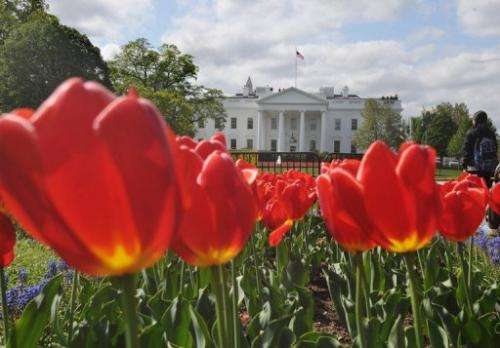Tulips are seen in a flower bed in Lafayette Square across from the White House on April 22, 2013 in Washington. Environmental groups on Tuesday said US President Barack Obama's plan to combat climate change is long overdue but will not be enough to reverse a global problem that is outpacing the solutions.
Environmental groups said Tuesday that US President Barack Obama's plan to combat climate change is long overdue but not enough to reverse a global problem that is outpacing the solutions.
Some experts warned it will be an uphill battle to implement the policies Obama announced, using his executive powers since US lawmakers are unable to come to agreement on how to preserve the economy while cutting pollution.
A key obstacle will be to finalize standards on power plants before Obama leaves office in three years, and the missing link is a carbon tax to punish polluters and reward greener power endeavors, some experts said.
The Center for Biological Diversity described Obama's plan as "modest" and warned it falls short by failing to set a nationwide pollution cap for carbon dioxide at no greater than 350 parts per million.
"We're happy to see the president finally addressing climate change but the plain truth is that what he's proposing isn't big enough, and doesn't move fast enough, to match the terrifying magnitude of the climate crisis," said senior counsel Bill Snape.
"The White House can't punt on hard climate questions," he added, noting that the plans ignores dangers posed by Arctic drilling and fracking for natural gas.
Snape also said the plan aims to put the US on the path to cutting greenhouse gas emissions by four percent below 1990 levels by 2020, though that reduction would fall short of US pledges under the Kyoto Protocol "and would not be enough to avert catastrophic temperature rises, according to climate scientists."
Obama's plan did not specifically address the controversial Keystone XL pipeline proposal, but he said in his speech at Georgetown University it would only go forward if it "does not significantly exacerbate the problem of carbon pollution."
The project aims to build a 1,980-mile (3,200-kilometer) conduit for oil from Canada's tar sands region to the US Gulf Coast.
A centerpiece of Obama's strategy involves power plants, which are responsible for 40 percent of US carbon pollution but have no limits imposed by the federal government on how much they may release.
The president called on the Environmental Protection Agency to issue a proposal to regulate carbon dioxide from existing coal plants by 2014 and make it final by 2015, but there are no details on what that would entail or cost.
"Power plant carbon standards will be job one and he'll need to make sure they're finalized well before his administration ends," said Alden Meyer, strategy and policy director of the Union of Concerned Scientists (UCS).
"Ultimately, we will also need a price on carbon emissions that reflects the rising costs of climate change. Congress will have to step up to the plate," said Meyers.
The UCS and the World Resources Institute agreed that Obama's goal, announced in 2009, of reducing harmful greenhouse gas emissions by 2020 to 17 percent below 2005 levels is possible.
"Tackling carbon pollution from power plants is the greatest opportunity and should be at the core of any serious approach to reduce US emissions. For the first time, a US president is taking such action," said Andrew Steer, WRI president.
While many experts applauded Obama for finally announcing some action, they also cautioned that global warming is growing worse.
"The problem has become much bigger while the US was ignoring it," said Saleemul Huq, senior fellow in the International Institute for Environment and Development's climate change group.
"Hence the world is now headed towards 4-degree temperature rise by 2100 unless much more drastic actions are undertaken on mitigation by all countries including the United States."
"President Obama says he wants the US to lead this effort globally. His promise is welcome, but his actions still fall short of what is required."
According to Eileen Claussen, president of the Center for Climate and Energy Solutions, implementing the plan will "be extremely challenging."
"But a clear majority of the American public favors stronger climate action, and with a plan in place, the administration must now follow through with a true sense of urgency," Claussen said.
© 2013 AFP
























